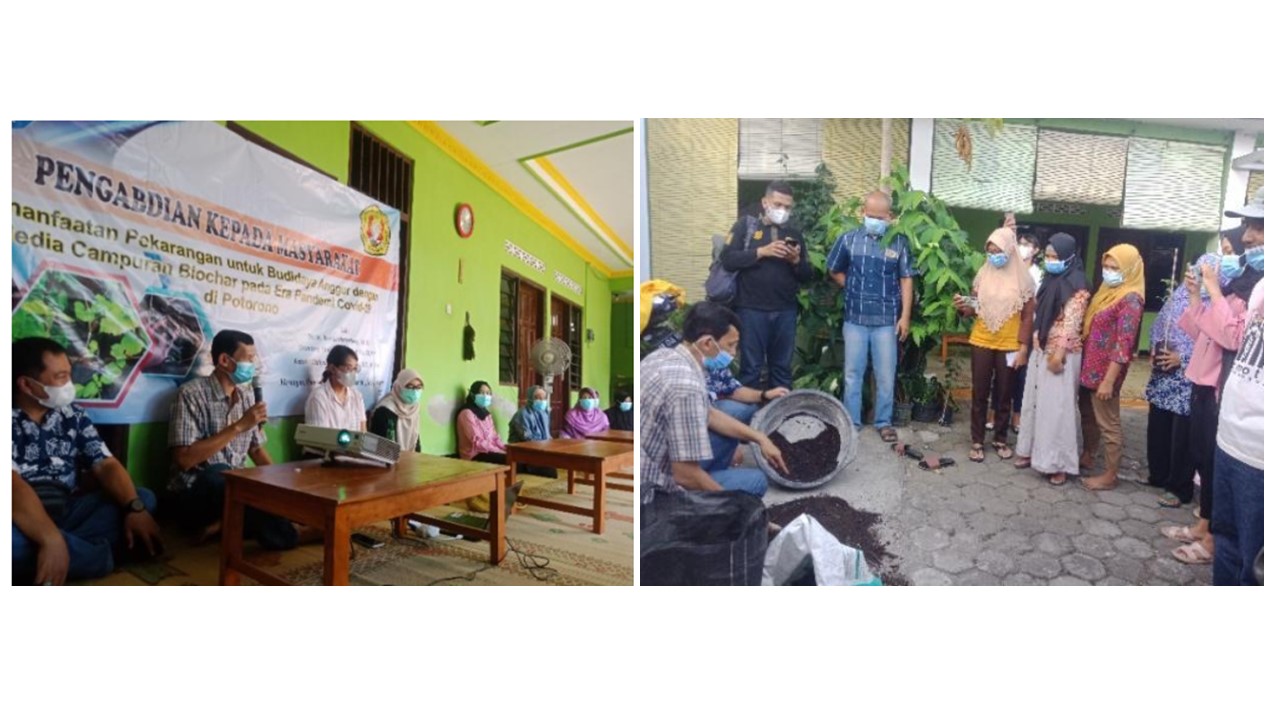Community Empowerment With the Utilization of Yards For Grape Cultivation Using Biochar Mixed Media In Covid-19 Pandemic
DOI:
https://doi.org/10.12928/spekta.v3i1.4707Keywords:
Biochar, Wine Cultivation, Yard, Community serviceAbstract
Background: The social economic impact of the Covid-19 pandemic was felt by all levels of Indonesian society, especially the people in Mayungan, Potorono Village, Bantul Regency. Currently, compost houses and waste banks have been formed from the collection of household waste in RT 04 and RT 05 with a capacity of 1.5 tons per week. Community service activities were carried out in the form of using the yard for grape cultivation with mixed media of biochar. Mixed media technology is expected to increase the efficiency of agricultural costs and productivity of grape cultivation.
Contribution: Seeing the great potential of Mayungan and as an effort to improve the psychological aspects of the community due to the Covid-19 pandemic, community service activities were carried out using the yard for grape cultivation with biochar mixed media.
Method: The approach method used is the method of active community participation.
Results: The implementation of the Internal Community Service program uses the lecture, discussion, practice, mentoring and technical guidance methods. Community service activities can be carried out properly and have the expected impact.
Conclusion: Community service activities can be carried out properly. The empowerment program in the midst of the ongoing COVID-19 pandemic can relieve the mental burden of the community psychologically to strengthen the body's resistance to virus attacks through plant care every time
References
Y. C. Wu, C. S. Chen, and Y. J. Chan, “The outbreak of COVID-19: An overview,” J. Chinese Med. Assoc., vol. 83, no. 3, pp. 217–220, 2020, doi: 10.1097/JCMA.0000000000000270.
Menteri Dalam Negeri Republik Indonesia, Instruksi Menteri Dalam Negeri Nomor 30 Tahun 2021 Tentang Pemberlakuan Pembatasan Kegiatan Masyarakat Level 4, Level 3, dan Level 2 Corona Virus Disease 2019 di Wilayah Jawa dan Bali. 2021, pp. 1–25.
Pemerintah Kabupaten Bantul, “Dampak dan Upaya Pemulihan Sosial Ekonomi Masyarakat di Kabupaten Bantul Akibat Covid-19,” Pemerintah Kabupaten Bantul, 2020.
P. H. Brunner and H. Rechberger, “Waste to energy—key element for sustainable waste management,” Waste Manag., vol. 37, pp. 3–12, 2014, doi: https://doi.org/10.1016/j.wasman.2014.02.003.
E. Amasuomo and J. Baird, “The Concept of Waste and Waste Management,” J. Manag. Sustain., vol. 6, no. 4, p. 88, 2016, doi: 10.5539/jms.v6n4p88.
A. Demirbas, “Waste management, waste resource facilities and waste conversion processes,” Energy Convers. Manag., vol. 52, no. 2, pp. 1280–1287, 2011, doi: https://doi.org/10.1016/j.enconman.2010.09.025.
N. Dixon and D. R. V Jones, “Engineering properties of municipal solid waste,” Geotext. Geomembranes, vol. 23, no. 3, pp. 205–233, 2005, doi: https://doi.org/10.1016/j.geotexmem.2004.11.002.
P. R. White, M. Franke, and P. Hindle, Integrated Solid Waste Management: A Lifecycle Inventory. Berlin: Springer, 1995.
S. Herlambang, A. Z. P. B. Santosa, and S. Rina, Petunjuk Teknis Pembuatan Biochar Dengan Sistem Selongsong Putar. Yogyakarta: Gerbang Media Askara, 2017.
S. Herlambang, A. P. B. Santosa, H. T. Sutiono, and S. R. Nugraheni, “Alat Pembuatan Biochar dengan Sistem Selongsong Putar,” 2019.
N. L. Nurida, A. Rachman, and S. Sutono, Biochar Pembenah Tanah yang Potensial. Jakarta: IAARD Press, 2015.
J. Lehmann and S. Joseph, “Biochar for environmental management: An introduction,” in Biochar for Environmental Management: Science and Technology, vol. 1, 2012, pp. 1–12.
E. Suwarno, E. Suhesti, and Nahlunnisa, “Pengembangan Agroforestry Sederhana Di Sekitar Rumah,” Din. J. Pengabdi. Kpd. Masy., vol. 2, no. 2, pp. 113–120, 2018, doi: 10.31849/dinamisia.v2i2.1255.
E. Djuwendah, T. Karyani, Z. Saidah, and O. Hasbiansyah, “Pelatihan Budidaya Sayuran Secara Vertikultur di Pekarangan Guna Ketahanan Pangan Rumah Tangga,” Din. J. Pengabdi. Kpd. Masy., vol. 5, no. 2, pp. 349–355, 2021, doi: 10.31849/dinamisia.v5i2.5291.
G. M. S. Wibawa, I. D. G. Agung, and I. K. Suamba, “Efektivitas Penggunaan Faktor Produksi Usahatani Anggur di Desa Kalianget , Kecamatan Seririt , Kabupaten Buleleng,” J. Agribisnis dan Agrowisata, vol. 9, no. 1, pp. 89–98, 2020.
B. Glaser, J. Lehmann, and W. Zech, “Ameliorating physical and chemical properties of highly weathered soils in the tropics with charcoal - A review,” Biol. Fertil. Soils, vol. 35, no. 4, pp. 219–230, 2002, doi: 10.1007/s00374-002-0466-4.
N. L. Nurida, A. Dariah, and A. Rachman, “Peningkatan Kualitas Tanah Dengan Pembenah Tanah Biochar Limbah Pertanian,” J. Tanah dan Iklim, vol. 37, no. 2, pp. 69–78, 2013, doi: 10.2017/jti.v37n2.2013.69-78.
L. Rombough, The grape grower: A guide to organic viticulture. Chelsea Green Publishing, 2002.
I. G. A. Gunadi and I. K. Sumiartha, “Pertumbuhan Bibit Anggur Prabu Bestari Asal Okulasi pada Berbagai Campuran dan Kandungan Air Media Tanam,” AGROTROP, vol. 9, no. 1, pp. 42–55, 2019.
S. Herlambang, A. P. B. Santosa, H. T. Sutiono, and S. R. Nugraheni, “Application of coconut biochar and organic materials to improve soil environmental,” 2019, doi: doi: 10.1088/1755-1315/347/1/012055.
S. Herlambang, A. Z. Purwono, M. Gomareuzzaman, and A. W. A. Wibowo, Biochar: Salah Satu Alternatif untuk Perbaikan Lahan dan Lingkungan. Yogyakarta: LPPM UPN “Veteran” Yogyakarta, 2020.

Downloads
Published
How to Cite
Issue
Section
License
Copyright (c) 2022 Susila Herlambang, Danang Yudhiantoro , Astrid Wahyu Adventri Wibowo

This work is licensed under a Creative Commons Attribution-ShareAlike 4.0 International License.
Authors who publish with SPEKTA (Jurnal Pengabdian Kepada Masyarakat: Teknologi dan Aplikasi) agree to the following terms:
- Authors retain copyright and grant the journal the right of first publication with the work simultaneously licensed under a Creative Commons Attribution License (CC BY-SA 4.0) that allows others to share the work with an acknowledgment of the work's authorship and initial publication in this journal.
- Authors are able to enter into separate, additional contractual arrangements for the non-exclusive distribution of the journal's published version of the work (e.g., post it to an institutional repository or publish it in a book), with an acknowledgment of its initial publication in this journal.
- Authors are permitted and encouraged to post their work online (e.g., in institutional repositories or on their website) prior to and during the submission process, as it can lead to productive exchanges, as well as earlier and greater citation of published work.

This work is licensed under a Creative Commons Attribution-ShareAlike 4.0 International License.









